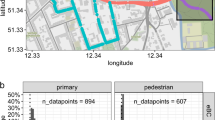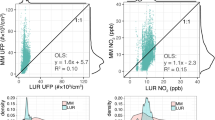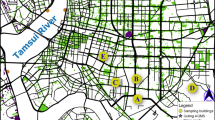Abstract
Large-scale exposure assessments that include both between- and within-city differences in air pollution levels are lacking. The objective of this study was to model long-term particle exposure for the whole of Sweden, separating long-range transport from local sources, which were further separated into combustion and road dust. Annual regional, urban and local traffic PM exposure contributions were modeled for 26,000 addresses from a national survey, using a European scale model, an urban model and a local traffic model. Total PM10 was overall dominated by the regional contribution, ranging from 3.5 μg/m3 (northernmost) to 13.5 μg/m3 (southernmost). Local traffic and urban sources contributed nationally on average to 16% of total PM10, but for urban populations this contribution was larger (for Stockholm around 30%). Generalized to the Swedish adult population, the average residential exposure contributions from regional, urban and local traffic PM10 were 10.2, 1.3 and 0.2 μg/m3, respectively. Corresponding exposure to PM1 was 5.1, 0.5 and 0.03 μg/m3, respectively. Long-range transport dominates average Swedish residential PM1 and PM10 levels, but for urban populations the contributions from urban and local traffic sources are important and may even dominate for residences close to heavily trafficked roads. The study shows the importance of considering both national and city-scale gradients. The approach to exposure modeling at home addresses of a Swedish cohort includes both the regional scale and the urban and local traffic contributions to total PM exposure. With this we can resolve both between- and within-city gradients in national exposure assessments. The within-city exposure is further divided into a submicron (combustion) and a supermicron (road dust generated by studded tires) part. This gives new possibilities to study health impacts of different particles generated in Scandinavian cities.
This is a preview of subscription content, access via your institution
Access options
Subscribe to this journal
Receive 6 print issues and online access
$259.00 per year
only $43.17 per issue
Buy this article
- Purchase on Springer Link
- Instant access to full article PDF
Prices may be subject to local taxes which are calculated during checkout







Similar content being viewed by others
Abbreviations
- GIS:
-
Geographical Information Systems
- PM1:
-
particulate matter <1 μm in microgram per cubic meter (μg/m3), also named submicron particles
- PM10:
-
particulate matter <10 μm in microgram per cubic meter (μg/m3)
- PM10-1:
-
particulate matter <10 μm and >1 μm, in microgram per cubic meter (μg/m3), also named supermicron particles
- SMHI:
-
Swedish Meteorological and Hydrological Institute
References
Jerrett M, Arain A, Kanaroglou P, Beckerman B, Potoglou D, Sahsuvaroglu T et al A review and evaluation of intraurban air pollution exposure models. J Expo Anal Environ Epidemiol 2005; 15 (2): 185–204.
Bellander T, Berglind N, Gustavsson P, Jonson T, Nyberg F, Pershagen G et al Using geographic information systems to assess individual historical exposure to air pollution from traffic and house heating in Stockholm. Environ Health Perspect 2001; 109 (6): 363–369.
Briggs DJ, de Hoogh C, Gulliver J, Wills J, Elliott P, Kingham S et al A regression-based method for mapping traffic-related air pollution: application and testing in four contrasting urban environments. Sci Total Environ 2000; 253 (1-3): 151–67.
Moore DK, Jerrett M, Mack WJ, Künzli N . A land use regression model for predicting ambient fine particulate matter across Los Angeles, CA. J Environ Monit 2007; 9 (3): 246–52.
Nyberg F, Gustavsson P, Järup L, Bellander T, Berglind N, Jakobsson R et al Urban air pollution and lung cancer in Stockholm. Epidemiology 2000; 11 (5): 487–95.
Rosenlund M, Berglind N, Hallqvist J, Jonsson T, Pershagen G, Bellander T . Long-term Exposure to Urban Air Pollution and Myocardial Infarction. Epidemiology 2006; 17 (4): 383–90.
Nordling E, Berglind N, Melén E, Emenius G, Hallberg J, Nyberg F et al Traffic related air pollution and childhood respiratory symptoms, function and allergies. Epidemiology 2008; 19 (3): 401–408.
Jerrett M, Finkelstein MM, Brook JR, Arain MA, Kanaroglou P, Stieb DM et al A cohort study of traffic-related air pollution and mortality in Toronto, Ontario, Canada. Environ Health Perspect 2009; 117 (5): 772–777.
Forsberg B, Hansson H-C, Johansson C, Areskoug H, Persson K, Järvholm B . Comparative health impact assessment of local and regional particulate air pollutants in Scandinavia. Ambio 2005; 34 (1): 11–19.
Andersson C, Bergström R, Johansson C . Population exposure and mortality due to regional background PM in Europe – long-term simulations of source-region and shipping contributions. Atmos Environ 2009; 43: 3614–3620.
Meister K, Johansson C, Forsberg B . Estimated short-term effects of coarse particles on daily mortality in Stockholm, Sweden. Environ Health Perspect 2012; 120 (3): 431–436.
Willers S, Eriksson C, Gidhagen L, Nilsson ME, Pershagen G, Bellander T . Fine and coarse particle pollution and respiratory health in Sweden: the ROADSIDE study. 2012 European Respiratory Journal, in press.
Gidhagen L, Johansson H, Omstedt G . SIMAIR – Evaluation tool for meeting the EU directive on air pollution limits. Atmos Environ 2009; 43 (5): 1029–1036.
Robertson L, Langner J, Engardt M . An Eularian limited-area atmospheric transport model. J of Applied Meteorology 1999; 38: 190–210.
Robertson L, Kahnert M . 2D variational data assimilation of near-surface chemical species. In: Borrego C, Renner E, (eds.) 2007 Air Pollution Modeling and Its Application XVIII. Elsevier Amsterdam.
André M, Rapone M . Analysis and modelling of the pollutant emissions from European cars regarding the driving characteristics and test cycles. Atmos Environ 2009; 43 (5): 986–995.
Omstedt G, Bringfelt B, Johansson C . A model for vehicle induced non-tailpipe emissions of particles along Swedish roads. Atmos Environ 2005; 39 (33): 6088–6097.
Berkowicz R . A simple model for urban background pollution. Environ Monit and Assessment 2000; 65: 259–267.
Omstedt G An operational air polution model. SMHI Report RMK nr 57 1988 1–35 (available from kundtjanst@smhi.se.
Häggmark L, Ivarsson KI, Gollvik S, Olofsson PO . Mesan, an operational mesoscale analysis system. Tellus 2000; 52A: 1–20.
Swedish Road Administration. NVDB Contents – overview, NVDB Contents – feature types, NVDB Contents – road network (PDF reports 2008. http://www22.vv.se/nvdb2_templates/templates/SingleColumn____44994.aspx.
Omstedt G, Andersson S, Gidhagen L, Robertson L . Evaluation of new tools for meeting the targets of the EU Air Quality Directive: a case study on the studded tyre use in Sweden. Int. J. Environment and Pollution 2011; 47 (1/2/3/4): 79–96.
Sjödin Å, Ferm M, Björk A, Rahmberg M, Gudmundsson A, Swietlicki E et al WEAREM – Wear particles from road traffic. IVL Report B1830 2010 (available at http://www.ivl.se.
Johansson C, Andersson C, Bergström R, Krecl P . Exposure to particles due to local and non-local sources in Stockholm – estimates based on modeling and measurements 1997–2006. ITM Report 175 2008 (available at http://www.itm.su.se/.
Beelen R, Hoek G, Pebesma E, Vienneau D, de Hoogh K, Briggs DJ . Mapping of background air pollution at a fine spatial scale across the European Union. Sci Total Environ 2009; 407: 1852–1867.
Yttri K, Aas W, Tørseth K, Stebel K, Vik AF, Fjaeraa AM et alTransboundary particulate matter in Europe – Status Report 4/2010, EMEP, available at http://www.nilu.no/projects/ccc/reports/ accessed on October 2012 2010.
Genberg J, Hyder M, Stenström K, Bergström R, Simpson D, Fors EO et al Source apportionment of carbonaceous aerosol in southern Sweden. Atmos Chem Phys 2011; 11: 11387–11400.
Szidat S, Ruff M, Perron N, Wacker L, Synal H-A, Hallquist M et al Fossil and non-fossil sources of organic carbon (OC) and elemental carbon (EC) in Göteborg, Sweden. Atmos Chem Phys 2009; 9: 1521–1535.
Yttri K, Aas W, Tørseth K, Stebel K, Krstiansen NI, Myhre C,L et alTransboundary particulate matter in Europe – Status Report 4/2011, EMEP, available at http://www.nilu.no/projects/ccc/reports/ accessed on October 2012 2012.
Bergström R, Denier van der Gon HAC, Prévôt ASH, Yttri KE, Simpson D . Modelling of organic aerosols over Europe (2002–2007) using a volatility basis set (VBS) framework: application of different assumptions regarding the formation of secondary organic aerosol. Atmos Chem Phys 2012; 12: 8499–8527. http://www.atmos-chem-phys.net/12/8499/2012/.
Ketzel M, Omstedt G, Johansson C, Düring I, Pohjola M, Oettl M et al Estimation and validation of PM2.5/PM10 exhausted and non-exhausted emission factors for practical street pollution modelling. Atmos Environ 2007; 41 (40): 9370–9385.
Jensen SS, Bercowicz R, Hansen HS, Hertel O . A Danish decision-support GIS tool for management of urban air quality and human exposures. Transportation Research Part D-Transport and Environment 2001; 6 (4): 229–241.
Berkowicz R, Ketzel M, Jensen SS, Hvidberg M, Raaschou-Nielsen O . Evaluation and application of OSPM for traffic pollution assessment for a large number of street locations. Environ Modelling & Software 2008; 23: 296–303.
Jensen SS, Larson T, Deepti KC, Kaufamn JD . Modeling traffic air pollution in street canyons in New York City for intra-urban exposure assessment in the US Multi-Ethnic Study of atherosclerosis and air pollution. Atmos Environ 2009; 43 (30): 4544–4556.
SwedishEnvironmental Protection Agency Informative Inventory Report 2011 Sweden – submitted under the Convention on Lang-Range Transboundary Air Pollution.
Querol X, Alastuey A, Ruiz CR, Artiñano B, Hansson HC, Harrison RM et al Speciation and origin of PM10 and PM2.5 in selected European cities. Atmos Environ 2004; 38 (38): 6547–6555.
Acknowledgements
This work has been supported by grants from the Swedish Research Council Formas.
Author information
Authors and Affiliations
Corresponding author
Ethics declarations
Competing interests
The authors declare no conflict of interest.
Rights and permissions
About this article
Cite this article
Gidhagen, L., Omstedt, G., Pershagen, G. et al. High-resolution modeling of residential outdoor particulate levels in Sweden. J Expo Sci Environ Epidemiol 23, 306–314 (2013). https://doi.org/10.1038/jes.2012.122
Received:
Revised:
Accepted:
Published:
Issue Date:
DOI: https://doi.org/10.1038/jes.2012.122
Keywords
This article is cited by
-
Particle concentrations, dispersion modelling and evaluation in southern Sweden
SN Applied Sciences (2020)



